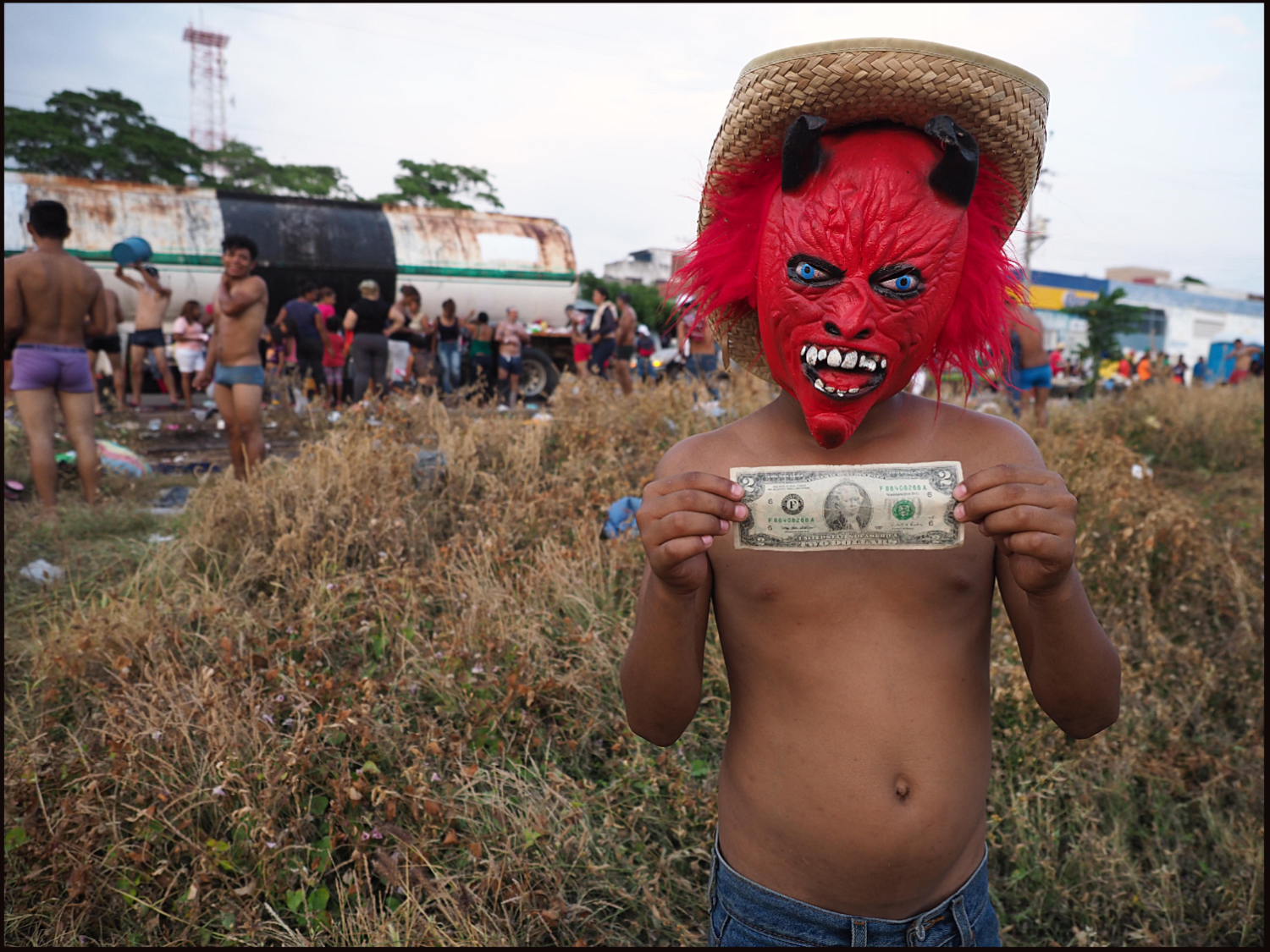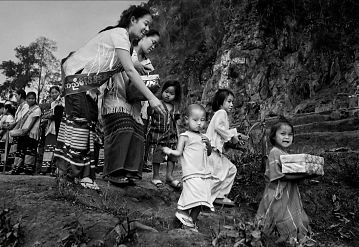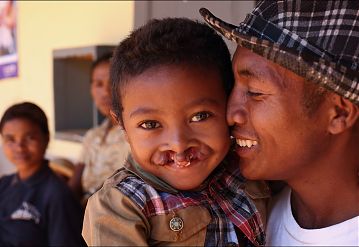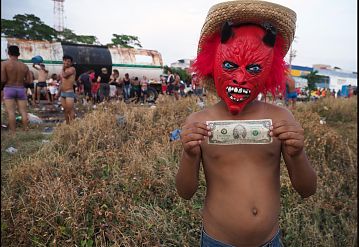Interview by Si Barber
Lexie, you're based in Mexico, having previously worked in London. What drew you to the southern part of the North American continent?
That’s a long story… it involves long-lost loves (not mine), open water swimming and a desire for change. I was working as a lawyer, hunting for careers advice to change career and a very wise woman told me that I should pick my top three ideas and pursue them for a year. So I worked as a photojournalist, I volunteered in a shelter for sex workers and worked for the Mexican Government advising on rights of migrants facing deportation from the US. Photography was one the that has always stuck with me.
You've described Mexico as a “photographer’s playground” , can you expand on that?
It’s a combination of colours, people who are open to inviting you into their homes or businesses, who want you to be part of their lives and to share with the world. Everything is new, every day is different and everyone (pretty much) wants to be photographed.
Your work focuses on the human effects of global events and poverty, in particular migration and women's issues. How do you build trust with the communities and individuals you photograph, especially in sensitive contexts?
I remember working as a fixer for a Magnum photographer back in 2018 during the migrant caravan. At the end of the day he said to me, can I give you some advice? Sure, I thought because he was Magnum and I am not… he said “work more, talk less”. I think about his advice all the time as I wholeheartedly disagree with it. In my work, I have to take time to get to know communities and for them to trust me. Maybe I’ll never work for Magnum or be as good as him, but I prefer to work this way. Especially when publishing someone’s picture can be the difference between life or death for some people. I’d rather hear their story and then take their picture.
Your portfolio blends intimate portraits, ie life for Central Americans amid flooding along with news images concerning election security for political candidates. How do you decide between still photography, videography, or multimedia formats, and what technical choices, like equipment or editing, help convey authenticity in sensitive narratives?
This is one of the hardest choices for me. I feel like I am always juggling but lately I say no to people who want photos and video. I think when I’m doing photo, video and text, the quality suffers. But the issue at the moment s that I just couldn’t find the budgets to do just one, so I had to become a jack of all trades, and possibly master of none. I’m currently back on a photography push, whilst working on editing a film about women in prison.
Since President Trump came to office deportations of people to Mexico have become commonplace. Have you had to change your approach to keep the story fresh for the public eye?
I actually haven’t worked on migration stories for a while. I was almost full time in migration for a few years, working on a film for Rory Kennedy, stories and portraits. It became really difficult to hear similar stories and see the hatred for people who are forced to make treacherous journeys to safety. For the past two years I have been working on a story about women in prison in Mexico, which has brought its own challenges.
Having completed VICE's hostile environment course and the Thomson Foundation's Photographers Ethical Toolkit, can you describe a specific instance,where these skills were crucial for safety, ethics, or storytelling integrity?
I think living in Latin America and working predominantly on my own, I have to be aware of my surroundings and regularly use training or tips that security professionals have given me. The Frontline Freelance Register in London and a few British veterans have given me access to training that has probably kept me alive and certainly saved me emotionally. I think on the safety side of things in most of the difficult situations I’ve experienced here I have been lucky enough to be working alongside some really well trained professionals and being able to share some stories over a drink afterwards has helped to let some of the emotion out. I have three ex-military friends in particular who have helped me more than any course in their understanding and their empathy. I think listening to others without judgement (I mean colleagues and protagonists) and being heard without judgement is more valuable than any course. (Don’t tell Vice I said that! I am very grateful to their training and learning how to drag a body!)
How do you measure the impact of your photography in raising awareness or driving change for the communities you document? Have there been specific instances where your images directly influenced policy or public perception?
Gosh, that is a big question. It’s a big part of the film I’m working on at the moment. I have an impact grant from One World Media to assess whether the film about women in prisons will actually make a difference, so it’s part of journalism today and I think is possibly why many journalists get burned out because they are reporting but not seeing a difference. I know I have got very frustrated at some people’s beliefs and I have tried patiently to set the story right when listening to opinionated taxi drivers… but I don’t know if I have actually made a difference.
You have a masters degree on the subject of war and psychiatry. What role does your academic background play in the presentation of the subject before your camera?
I use my masters all the time. I specialised in a few subjects that regularly come up in interviews. For example, understanding the basics of trauma has helped me to recognise symptoms and behaviours in others, like always letting my interviewees face the door, meet in a quiet place, set up a session with a professional therapist after the interview to close down any trauma. It has also helped me to understand my own reactions to difficult situations. Although in my most recent project about sexual trauma of female prisoners, I think it’s hindering me because I’m so afraid to say anything because of knowing how vast the topic is and that there is no one answer. I think this also has led me to take longer to get to know people before photographing them and also not seeing survivors as victims. The women I work with are some of the strongest women I have ever met. Many training sessions will tell you to approach with caution and not ask direct questions, whereas the women I am working with regularly tell me how refreshing it is to be able to talk honestly about their trauma in a situation where they can talk and talk and talk, without being interrupted.
Your website states that you had a prolonged period of recovery after an accident. Illness is always a worry for freelancers. Did you find this changed your perspective on the balance between life and work?
Yes, I’m terrified of getting sick and losing my job. It has happened to me twice now… and is a constant fear. I like my current set up though because I have a very lovely law firm in London (Stephenson Harwood) that I consult for that gives me enough to keep me comfortable in the quiet times and means if something happens to my ability to walk again, I have an office job to fall back on. I always feel like a bit of a failure admitting that I earn from sources other than journalism, but the reality is that my freelance income was never stable with extreme highs and some extreme lows! This gives me the balance so I can choose photography jobs that almost certainly won’t pay me a fortune but are really fun (like the F1 or covering Rodeo’s in Mexico).
Your website mentions ongoing documentary work and exhibitions. What new stories or themes are you exploring over the next few years, and how do you see your role as a photographer evolving in response to global challenges like migration, climate change, or social justice?
I have mostly been working with women who have issues with their body or who have experienced horrific miscarriages of justice. I’m trying to use photography to give them a confidence boost and maybe raise awareness of an issue at the same time. I’m working on a film about Women in Prison in Mexico (half are legally innocent having never been sentenced, the rest are mostly innocent having been framed and most were sexually assaulted when they were first detained). Those statistics are shocking to me but it’s been a fight to try to get the story out. A few people lately have told me I’ve moved more into activism rather than journalism, but I really really hope that the film gets finished (I’m a really slow editor!) and that the text story comes out. My current project is taking portraits of women who have been released with items that got them through their years in prison. I recently had a call with another editor and my main question was ‘Am I mad to pursue this?’ I could sit on a beach and do nothing and I would earn the same… but I want to see it through. And fingers crossed it does make an impact!
See more work by Lexie Harrison Cripps





